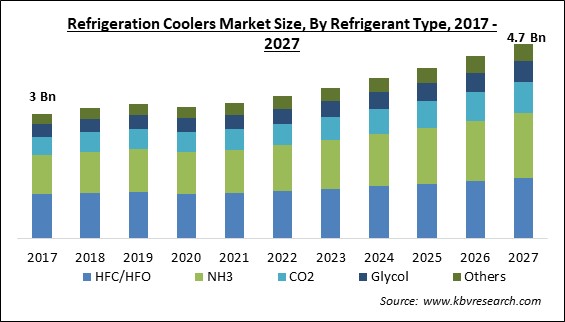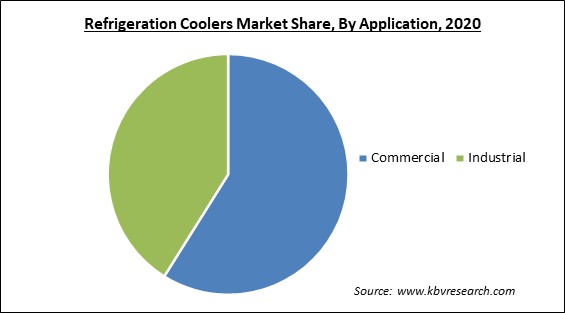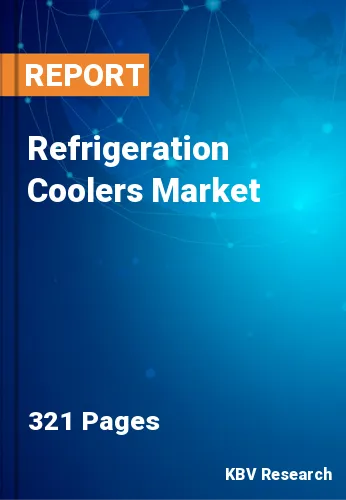The Global Refrigeration Coolers Market size is expected to reach $4.7 billion by 2027, rising at a market growth of 6.3% CAGR during the forecast period.
In recent years, consumer demand for frozen and chilled products has been increasing as a result of changing lifestyles and rising urbanization. In addition, fast growth in the organized retail sector, such as the expansion of hypermarkets and supermarkets, enhances overall sales of refrigeration coolers. Additionally, technological developments and an increase in the number of fast service restaurants, particularly in developing nations, are likely to create significant prospects for market expansion.
Some of the key trends of the refrigeration coolers market are higher investments in cold storage, global demand for frozen and processed foods, and the need for novel refrigeration coolers. In addition, natural refrigerant-based systems are being used in a wide range of commercial and industrial applications, which is a positive sign for the industry.
The refrigeration cooler market benefits from producing energy-efficient systems since it gives a more profitable solution to enterprises' needs while also addressing the need for a more environmentally responsible business approach. As improved storage systems extend across emerging economies, the industry is projected to grow. Moreover, companies are working to develop ecologically friendly and efficient refrigeration because it minimizes the quantity of energy wasted, efficiency is linked to sustainability. As the adoption of refrigeration coolers grows, so does energy consumption, pushing business owners to look for more cost-effective solutions.
Because of changing lifestyles and expanding urbanization, consumer demand for frozen and chilled commodities has increased, necessitating the use of commercial refrigeration coolers. In addition, rapid growth in the organized retail sector, such as the construction of hypermarkets and supermarkets, boosts global commercial refrigerator sales, hence supporting economic growth. On the other hand, the requirement for regular maintenance, as well as the likelihood of technical concerns arising from a lack of effective maintenance would be the obstacles to the growth of the market.

COVID-19 had a tremendous impact on the refrigeration industry due to the lockdown's devastating impact on the manufacturing sector in several places. Due to the abrupt shutdown in 2020, the indoor climate control, process cooling, and food cold chain technology industries had a significant decline because of disruptions in manufacturing, production, and demand and supply in refrigeration components.
Process cooling encompasses a variety of cooling techniques that are critical in a variety of industrial and commercial settings. Additionally, different refrigeration process equipment is required for these cooling operations, such as refrigeration coolers, which are used to chill, refrigerate, extract heat, or maintain temperature during manufacturing, production, or storage in many sectors. However, several manufacturing and production activities in the refrigerated coolers sector were suspended as a result of the unexpected lockdown. Various component manufacturers had to deal with problems that led to the development of cutting-edge process cooling solutions.
In the wake of the COVID-19 pandemic, increased demand for online grocery shopping and frozen food has prompted e-commerce businesses to put investment in refrigerated warehouses and cold storage. In addition, cold storage facilities have begun to be deployed in port-centric and coastal markets, as well as in close proximity to densely populated metro areas, in the United States. Factors such as the scarcity of land in metropolitan regions are driving cold storage companies to locate their operations near these places. In the year 2020, Lineage Logistics purchased many North American cold storage companies, including Allied Cold Storage, Southern Cold Storage, and Western Distribution Services. On 2020, Americold, on the other hand, invested a significant amount in cold storage purchases.
The demand for smart refrigeration, cold storage chain logistics, and transportation is directly proportional to the demand for fast-moving consumer goods (FMCG). The demand for refrigeration units to store and cool these products has increased as internet shopping and e-grocery have grown in popularity. Because some commodities are delicate, refrigerated logistics has limited time periods in which to distribute them. Food transportation from a warehouse or retail outlet to a customer location has also gotten more costly and difficult. In many countries, there has been a surge in demand for meal packages and e-grocery items. The need for cold-storage space has surged as a result of the abrupt increase in perishable food goods and consumables.
The demand for ammonia and carbon dioxide as refrigerants has increased dramatically as natural refrigerant-based systems have gained acceptance. The fact that these refrigerants have zero ODP and a low GWP has resulted in a rise in demand. Ammonia, for example, is a common refrigerant in industrial refrigeration facilities around the world, and it is environmentally safe and meets the low-GWP criteria. Ammonia, on the other hand, is considered a hazardous gas, and its inadvertent leaking in facilities can result in serious industrial mishaps. Lower ammonia concentrations can cause temporary blindness, eye damage, skin illnesses, and other respiratory diseases, whilst greater quantities can be lethal.

Based on Component, the market is segmented into Evaporators & Air coolers and Condenser. In 2020, the Evaporators & Air coolers segment acquired the highest revenue share of the Refrigeration Coolers Market. With sophisticated refrigeration systems, refrigeration is driving significant expansion in commercial and industrial applications. Because these components are broadly utilized in a variety of applications, they are available in a variety of forms and sizes to meet individual needs. For industrial and commercial cold storage, for example, a series of big capacity coolers are offered, especially when food safety, efficiency, and reliability are critical.
Based on Refrigerant Type, the market is segmented into HFC/HFO, NH3, CO2, Glycol, and Others. The NH3 segment held a significant revenue share of the Refrigeration Coolers Market in 2020. This is because concentrated ammonia is substantially colder than room temperature, it's a great choice for keeping things cool. In addition, ammonia is a substance that absorbs heat from one place and transports it to another for dissipation. Moreover, most people are familiar with CFC-based refrigeration systems, as well as older Freon-based systems.
Based on Application, the market is segmented into Commercial and Industrial. Based on Commercial Type, the market is segmented into Supermarkets & Hypermarkets, Convenience Stores & Mini Markets and Hospitality. Based on Industrial Type, the market is segmented into Refrigerated Warehouses, Beverage Processing, Fruit & Vegetable Processing, Dairy & Ice-cream Processing, Meat, Poultry, & Fish Processing and Others. In 2020, the Commercial segment obtained the largest revenue share of the Refrigeration Coolers Market. Heat recovery is a key contributor to minimizing energy consumption, particularly where space heating is a seasonal requirement, for larger supermarkets, energy use is generally deemed as a whole, including the building HVAC, water use, lighting, and commercial refrigeration.
| Report Attribute | Details |
|---|---|
| Market size value in 2020 | USD 3.2 Billion |
| Market size forecast in 2027 | USD 4.7 Billion |
| Base Year | 2020 |
| Historical Period | 2017 to 2019 |
| Forecast Period | 2021 to 2027 |
| Revenue Growth Rate | CAGR of 6.3% from 2021 to 2027 |
| Number of Pages | 321 |
| Number of Tables | 560 |
| Report coverage | Market Trends, Revenue Estimation and Forecast, Segmentation Analysis, Regional and Country Breakdown, Companies Strategic Developments, Company Profiling |
| Segments covered | Component, Refrigerant Type, Application, Region |
| Country scope | US, Canada, Mexico, Germany, UK, France, Russia, Spain, Italy, China, Japan, India, South Korea, Singapore, Malaysia, Brazil, Argentina, UAE, Saudi Arabia, South Africa, Nigeria |
| Growth Drivers |
|
| Restraints |
|
Based on Regions, the market is segmented into North America, Europe, Asia Pacific, and Latin America, Middle East & Africa. In 2020, the APAC emerged as the leading region in the overall Refrigeration Coolers Market. This is because of the increasing demand for refrigerated cooling units from commercial and industrial applications. In addition, APAC includes countries like China, India, and Japan, which are among the world's leading countries in terms of refrigerated warehouse capacity, and worldwide market players are seeing strong demand from China, India, Japan, and South Korea.
Free Valuable Insights: Global Refrigeration Coolers Market size to reach USD 4.7 Billion by 2027
The market research report covers the analysis of key stake holders of the market. Key companies profiled in the report include Johnson Controls International PLC, Emerson Electric Co., Carrier Global Corporation, Daikin Industries, Ltd., The Danfoss Group, Lennox International, Inc., Guntner GmbH & Co. KG, Evapco, Inc., Baltimore Aircoil Company Inc. (Amsted Industries), and Koxka.
By Component
By Refrigerant Type
By Application
By Commercial Type
By Industrial Type
By Geography
Companies Profiled
The global refrigeration coolers market size is expected to reach $4.7 billion by 2027.
Investments in refrigerated warehouses and cold storage facilities are increasing are driving the market in coming years, however, absence of qualified employees and serious safety concerns limited the growth of the market.
Johnson Controls International PLC, Emerson Electric Co., Carrier Global Corporation, Daikin Industries, Ltd., The Danfoss Group, Lennox International, Inc., Guntner GmbH & Co. KG, Evapco, Inc., Baltimore Aircoil Company Inc. (Amsted Industries), and Koxka.
The expected CAGR of the refrigeration coolers market is 6.3% from 2021 to 2027.
The HFC/HFO segment acquired maximum revenue share in the Global Refrigeration Coolers Market by Refrigerant Type 2020, thereby, achieving a market value of $1.4 billion by 2027.
The Asia Pacific is the fastest growing region in the Global Refrigeration Coolers Market by Region 2020, and would continue to be a dominant market till 2027.
Our team of dedicated experts can provide you with attractive expansion opportunities for your business.

